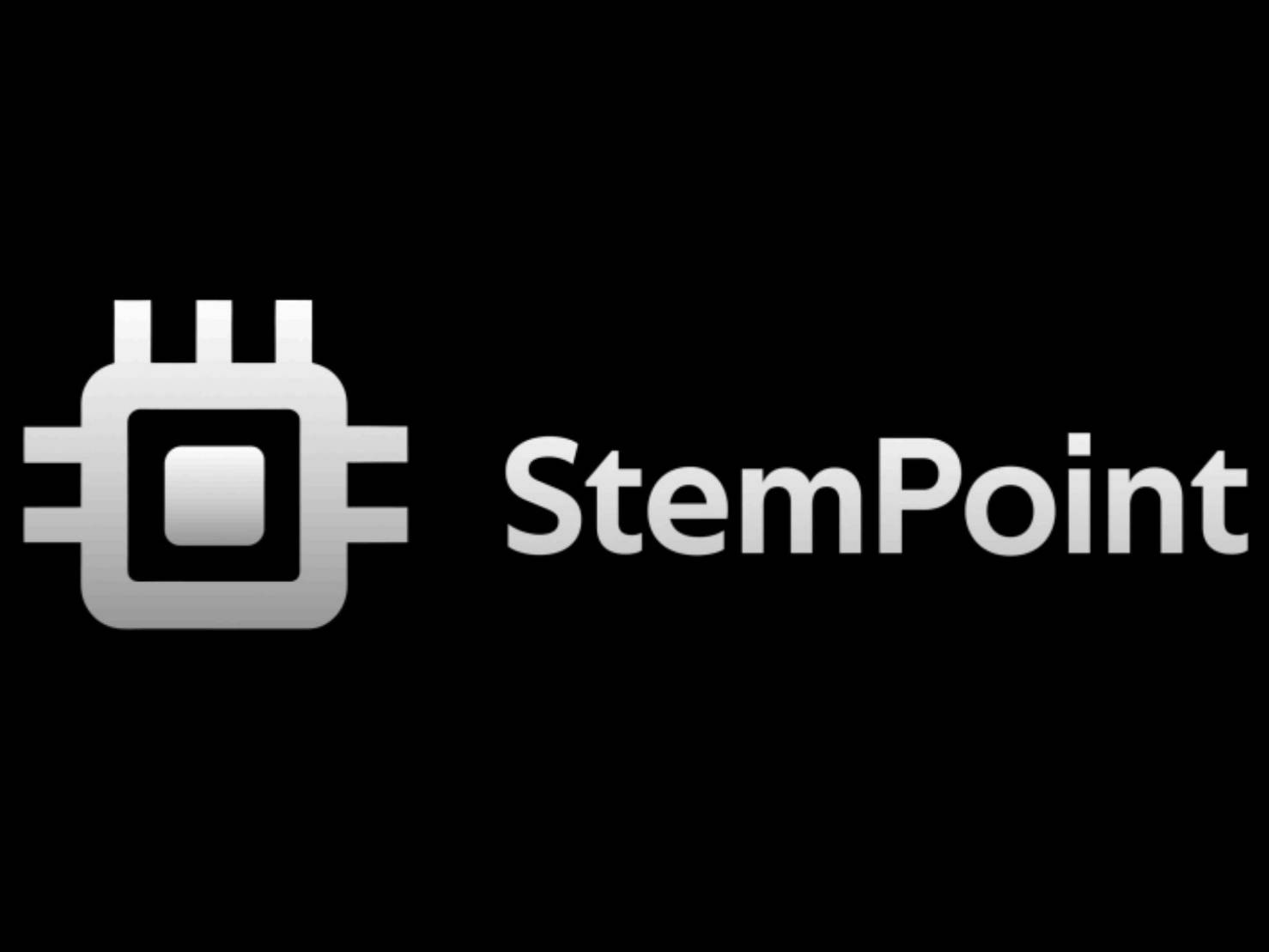Stempoint
Stempoint 是一个分布式人工智能 (AI) 基础设施平台,旨在通过整合对 AI 模型的访问与去中心化 GPU 计算资源网络,为 AI 开发提供统一的环境。该项目旨在通过将多模型 API 与按需计算能力相结合,为开发者和企业提供全面的解决方案。[1] [2]

概述
Stempoint 的开发旨在解决 AI 行业中的挑战,例如对各种基础 AI 模型的访问分散以及高性能 GPU 计算能力的高成本或稀缺性。该平台的目标是为 AI 模型训练、微调和推理创建一个单一的、面向全球的接口。它试图通过调动来自全球个人和机构提供商的未充分利用的 GPU 资源来实现这一目标,使其可以按需访问。[3]
该平台的核心设计结合了两个主要组件:AI 代理聚合层和混合计算基础设施。聚合层充当统一网关,简化了开发者与各种领先 AI 模型交互的方式。计算基础设施利用去中心化物理基础设施网络 (DePIN)以及集中式弹性云来为密集型 AI 任务提供必要的处理能力。这种混合方法旨在为用户提供灵活性、可扩展性和成本优化。[4]
生态系统
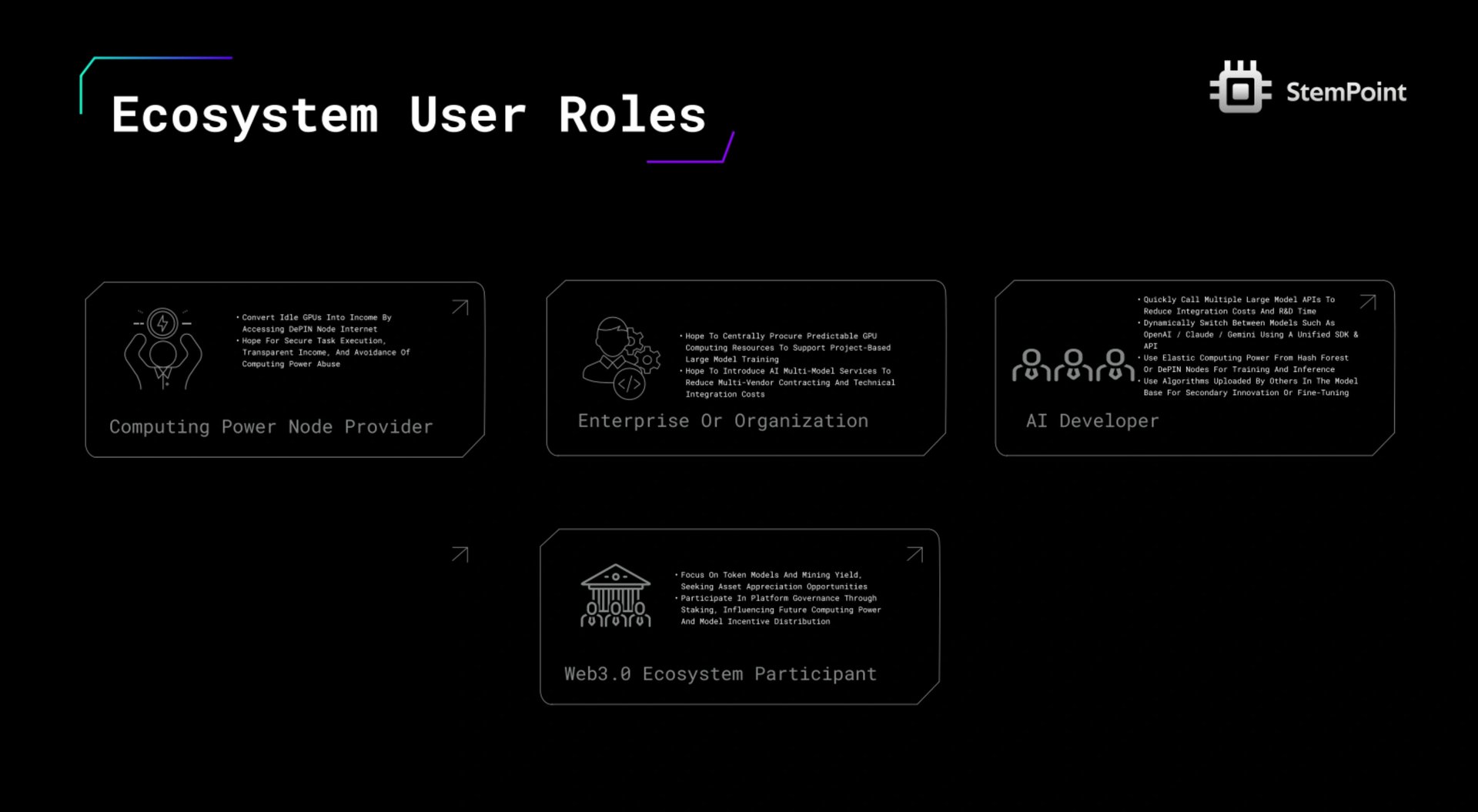
AI 开发者和个人构建者
以最小的摩擦访问多个基础模型和可扩展的 GPU 资源,产生 API 使用和计算需求,从而推动代币效用和网络活动。
企业和 AI 团队
利用大规模计算资源进行模型训练和部署,具有统一的计费和成本控制,提供一致的、高价值的需求,从而加强 Hash Forest 和 DePIN 网络。
算法和模型提供商
将专有 AI 模型转换为可访问的 API 以进行货币化,从而使平台的产品多样化并增加应用程序和模型交互的总体数量。
GPU 计算节点提供商
将闲置或商业 GPU 容量贡献给网络,以换取代币奖励,从而扩展去中心化基础设施并保持低延迟、弹性的计算可用性。
最终应用程序消费者 (B2B/B2C)
参与 AI 驱动的产品和服务(例如聊天机器人、生成工具和分析平台),创建现实世界的用例,从而加强生态系统的技术和经济基础。
Web3 投资者和治理参与者
质押或持有代币以参与治理决策并赚取收益,从而为生态系统的经济和决策框架增加流动性和长期稳定性。[13]
主要特点
公共和私有 AI 基础设施
提供具有托管运营、站点优化和完全可观察性的可定制本地和混合云集群。该系统支持高效的能源使用、成本控制和 AI 工作负载的可靠性。[6]
Hash Forest
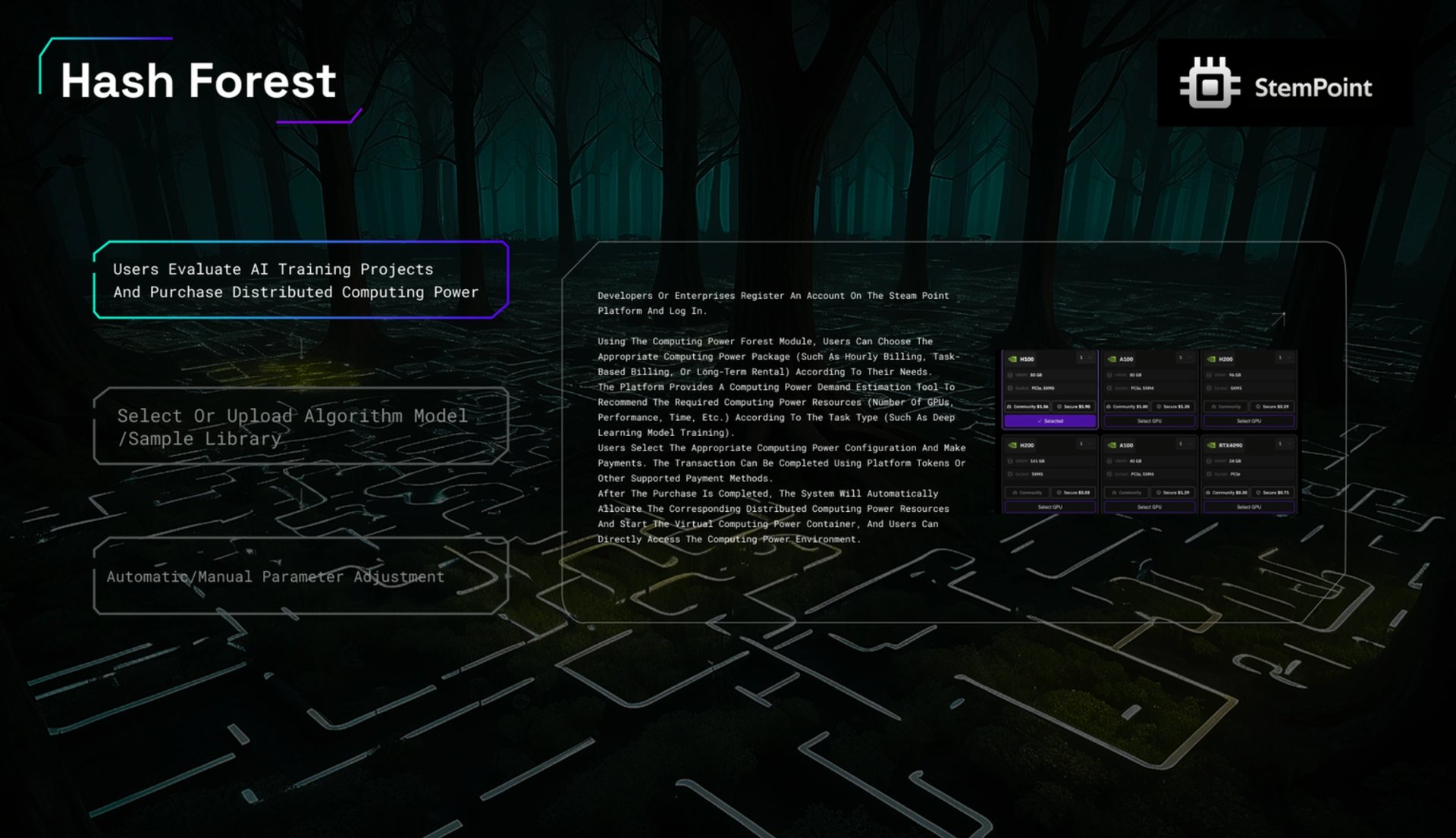
一个弹性 GPU 云网络,聚合全球闲置 GPU 用于 AI 训练和推理。它提供预配置的环境,其中包含主要的 AI 框架和自动化调度,以优化性能、延迟和成本。[7]
AI 计算能力市场
将计算资源标准化为模块化单元,以实现灵活的租赁。它包括用于计费、性能报告和基于延迟、成本或主权要求的战略路由的工具。[8]
AI 代理聚合层
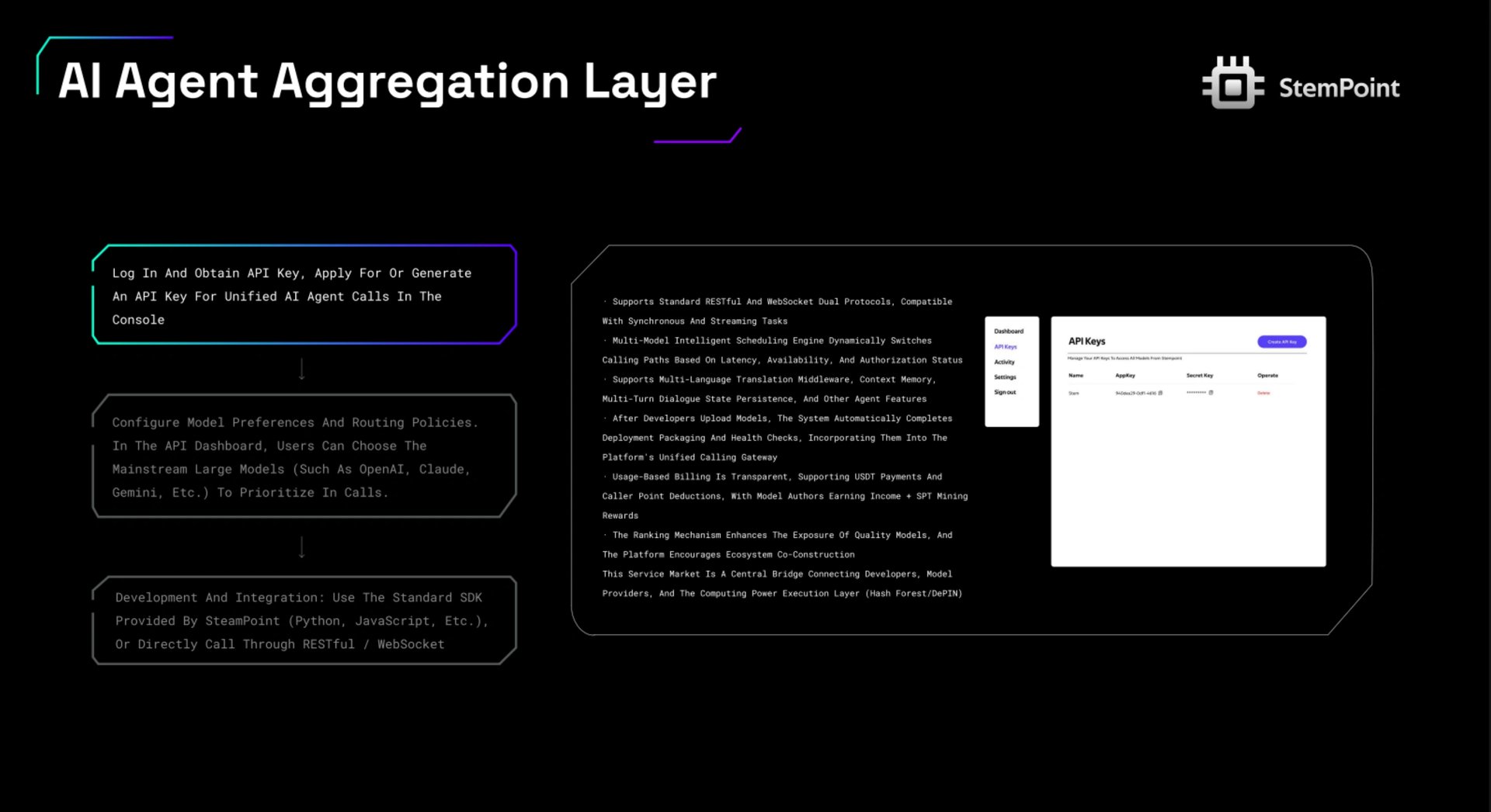
一个统一的 API,将多个基础模型(例如,OpenAI、Claude、Gemini)与动态路由、翻译和内存功能连接起来。它使开发者能够通过单个 SDK 高效地构建 AI 应用程序。[9]
AI 计算 RWA(现实世界资产)
将 GPU 集群所有权和收入权在链上代币化,从而实现透明的会计、收入分配和二级市场流动性。[10]
DePIN 节点网络
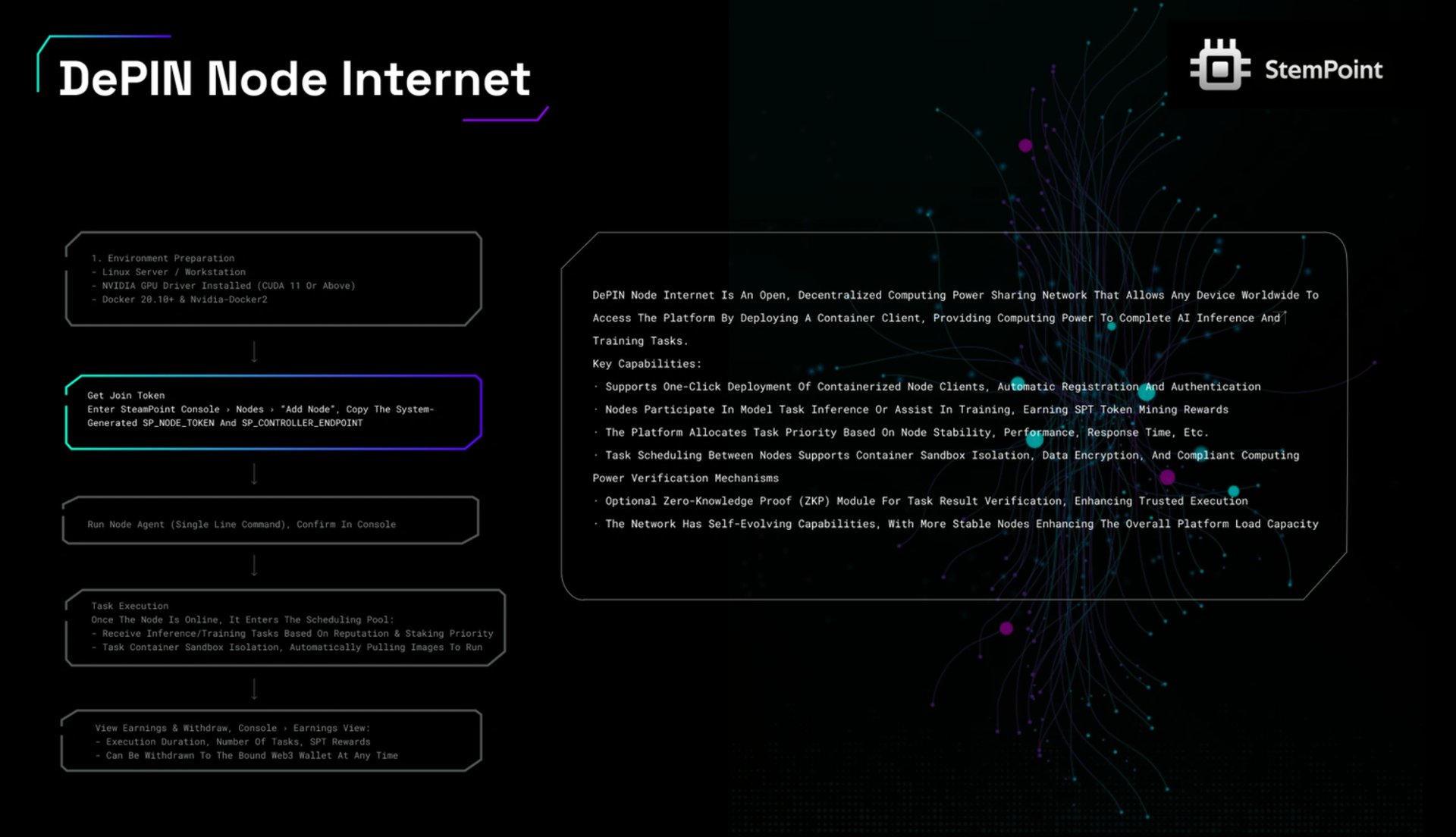
一个去中心化计算网络,参与者通过容器化客户端贡献 GPU 资源。节点安全地执行 AI 任务并获得代币化奖励,从而确保可扩展、可验证和分布式计算。[11]
边缘 AI 硬件共享挖矿
连接机器人和 NPU 等边缘设备,以在保护隐私的条件下执行轻量级 AI 计算,从而扩展网络边缘的数据和计算能力。[12]
用例
- AI 模型训练: 使用 Hash Forest 和 DePIN 网络的组合能力对大规模 AI 模型进行高性能分布式训练。
- AI 模型推理: 为需要实时或批量处理的已部署 AI 应用程序运行可扩展且经济高效的推理任务。
- AI 代理开发: 构建复杂的 AI 代理,这些代理需要持久的上下文内存并通过单个统一接口访问多个基础模型。
- 算法货币化: 将自定义或专有算法包装到可调用的、按次付费的 API 中,这些 API 可以提供给平台上的其他开发者。
- GPU 硬件货币化: 使个人和数据中心能够通过将其未充分利用的 GPU 硬件贡献给 DePIN 节点互联网来赚取被动收入。
- 研究与开发: 为研究人员和开发者提供按需访问强大的计算资源,以用于试验和微调自定义 AI 模型。[1] [2]
代币经济学
Stempoint 生态系统由其原生实用和治理代币 $SPT 提供支持,总供应量为 100 亿。该代币是平台运营不可或缺的一部分,创造了将计算资源提供商与 AI 应用程序开发者联系起来的经济激励。
- 挖矿:50%
- 基金会:15%
- 团队:10%
- 社区:5%
- 筹款:20%
代币效用
- 计算支付: 开发者和企业使用 SPT 来支付在 Hash Forest 和 DePIN 网络上进行 AI 模型训练和推理期间消耗的 GPU 资源,以及对 AI 代理聚合层的 API 调用。
- 节点奖励: 将其 GPU 硬件贡献给 DePIN 节点互联网的计算提供商因成功完成任务而获得 SPT 代币奖励。这是扩展网络容量的主要激励。
治理
Stempoint 的治理模型旨在允许利益相关者影响平台的战略方向。通过质押 SPT 代币,持有者可以获得对关键提案的投票权。这种机制旨在指导与计算能力激励、模型集成优先级和其他平台参数相关的决策。目标是创建一个去中心化和参与性的生态系统,让社区在项目的长期发展中拥有发言权。[4] [2]
